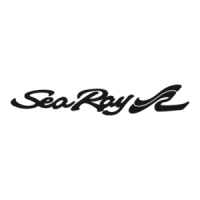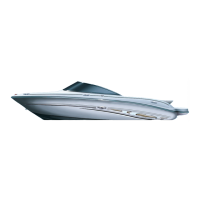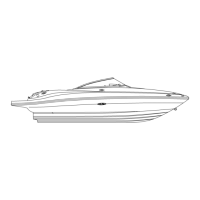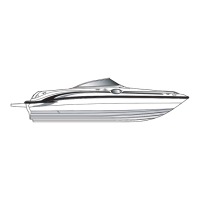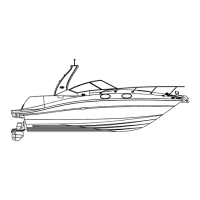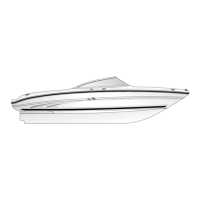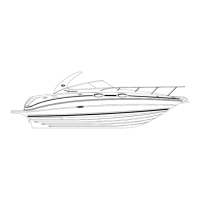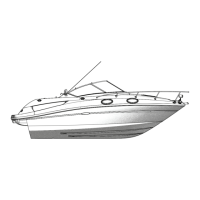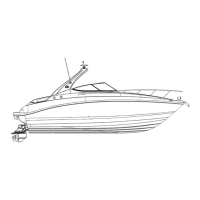Do you have a question about the Sea Ray 225 Weekender and is the answer not in the manual?
Details manual contents including safety, features, equipment, use, and maintenance.
Emphasizes operator's duty for safety, training, and following rules of the road.
Lists organizations for boating courses and recommended reading materials.
Outlines dealer's duties for pre-delivery, demonstration, and providing documentation.
Covers boat warranties and directs users to component-specific warranty information.
Explains the HIN as a key identifier and its importance for correspondence and orders.
Defines CE and NMMA certifications and their compliance standards.
Guides users to authorized dealers for service, parts, and repair, including issue resolution.
Outlines coverage for structural defects, parts, and laminate blisters, including timeframes.
Explains the process and conditions for transferring the limited warranty to a new owner.
Explains the purpose of safety labels and the meaning of DANGER, WARNING, CAUTION, and NOTICE.
Lists mandatory safety equipment like PFDs, fire extinguishers, and signaling devices.
Describes the automatic fire extinguisher system and its operation in case of fire.
Warns about CO hazards, symptoms, and prevention methods like ventilation.
Explains the function of CO monitors and the importance of familiarizing oneself with them.
Discusses the importance of PFDs for survival and legal requirements for carrying them.
Describes different types of Personal Flotation Devices (PFDs) and their intended uses.
Lists recommended safety equipment beyond legally mandated items for safe boating.
Warns against operating the boat under the influence of drugs or alcohol.
Explains how to determine safe load capacity from the certification plate.
Advises not to exceed maximum engine power rating and discusses propeller selection.
Discusses factors affecting boat stability and the dangers of exceeding load capacity.
Emphasizes operator awareness, safe speeds, and hazard identification.
Advises knowing boat handling, limitations, and modifying speed based on conditions.
Explains boat design categories and precautions for different weather conditions.
Stresses the importance of charting courses and avoiding hazards.
Provides safety guidelines for water sports like swimming and diving.
Gives safety advice for swimming around the boat, especially concerning engines.
Details safety precautions and hand signals for water skiing.
Explains diving flags and safe distances for dive operations.
Describes procedures for handling various emergency situations.
Outlines the legal obligation and procedure for assisting distressed boaters.
Recommends CPR certification and having a first aid kit on board.
Describes the steps for rescuing someone who has fallen overboard.
Warns about fire hazards and procedures for extinguishing or abandoning the boat.
Provides procedures for handling flooding, swamping, or capsizing events.
Details actions to take in case of a collision or leak.
Explains how to handle running aground and seeking assistance.
Advises on actions to take if the propulsion, control, or steering system fails.
Lists contact information for safety information and courses from the U.S. Coast Guard.
Lists international standards and specifications the vessel meets.
Addresses California-specific warnings about chemicals and environmental protection.
Prohibits discharging fuel or oily waste and details proper cleanup and disposal.
Covers regulations on overboard sewage discharge and garbage disposal.
Advises operating the boat quietly out of courtesy to others.
Warns about the dangers of wakes and advises reducing speed in congested areas.
Provides definitions for common nautical terms.
Explains common symbols used on controls and in the manual for better understanding.
Illustrates the locations of various safety and warning labels on the boat.
Provides guidance on using cleats, stern eyes, and slings for boat handling.
Details where passengers should be seated and secured for safety.
Describes the stern drive propulsion system, including the engine and lower unit.
Lists key dimensions and clearance specifications for the boat.
Discusses propeller selection and the importance of not exceeding engine RPM.
Illustrates the general layout of the boat's deck and major components.
Shows the layout of the boat's cabin area, including seating and amenities.
Identifies gauges and switches at the helm station for boat operation.
Shows locations of through-hull cutouts like bilge pump and drains.
Explains the operation of major boat controls.
Explains the operation of the gear shift and throttle control for engine speed and boat movement.
Describes the power trim system for adjusting the stern drive angle and its effect on performance.
Explains the function of the trailer switch for raising the drive unit for trailering.
Details the optional transom-mounted trim switch for trailering convenience.
Describes the trim tab system for adjusting boat listing and balance.
Explains the purpose of the ignition shutdown switch for safety.
Describes the boat's important gauges and their functions.
Explains tachometer for RPM and hour meter for tracking engine time.
Describes the function of basic engine and system gauges.
Discusses compass adjustment, care, and its role in navigation.
Covers the use of navigation and anchor lights for visibility and safety.
Provides critical pre-use, in-water, and post-trip checks for boat operation.
Emphasizes safe towing, launching, and loading procedures for boat and trailer.
Details safe fueling procedures, precautions, and recommendations.
Shows the routing of fuel lines from the tank to the engine.
Explains the function of the anti-siphon valve and its emergency use.
Gives advice on safely boarding the boat, including load capacity and assistance.
Covers PFD requirements, usage, and accessibility for passengers.
Stresses the importance of instructing passengers on boat behavior and seating.
Provides safety checks and procedures for starting the boat's engines.
Explains how to engage forward and reverse gears and basic boat movement.
Details the procedure for safely shutting down the engines.
Describes the boat's steering system and the importance of proper maintenance.
Outlines maintenance steps for the power steering system, including fluid checks.
Covers bilge system components and operations.
Prohibits discharging fuel or oily waste and details proper cleanup and disposal.
Emphasizes installing and tightening the drain plug before launching to prevent sinking.
Explains bilge pump operation, float switch, and manual vs. auto modes.
Shows how the bilge pump hose is routed to the thru-hull vent.
Illustrates the components of the bilge pump assembly.
Details maintenance for float switches and bilge pump intakes.
Explains the function of bilge blowers in preventing explosive gasoline fumes.
Shows the bilge blower setup, especially for diesel engines.
Covers engine and stern drive maintenance, operation, and potential issues.
Stresses the importance of engine maintenance for reliable operation.
Discusses expected vibration and common causes requiring prompt correction.
Warns about potential damage to the stern drive from impacts and how to mitigate it.
Provides a step-by-step guide for removing and installing the boat's propeller.
Illustrates the layout of components within the boat's bilge area.
Describes the standard gasoline fuel system components, including tank, vent, and anti-siphon valve.
Shows the routing of fuel lines from the tank to the engine.
Explains the function of the anti-siphon valve and its emergency use.
Describes the optional diesel fuel system components.
Details maintenance for fuel filters, emphasizing checking tightness and draining water.
Provides step-by-step instructions for draining water from the fuel filter.
Gives instructions for replacing the fuel filter element.
Lists essential safety precautions for fueling any boat, including diesel.
Covers general fueling practices like daylight fueling and checking fill plates.
Provides a checklist of actions before and during fueling for safety.
Offers a checklist of actions to perform after fueling is completed.
Describes the boat's electrical system.
Explains the boat's 12V DC electrical system, power sources, and battery connections.
Covers battery safety, maintenance, charging, and types of chargers.
Illustrates battery cable routing for single and optional dual battery systems.
Shows battery cable routing specifically for Mercury Diesel options.
Explains the function and location of the battery switch for controlling power delivery.
Details how to use the optional dual battery switch for system operation.
Warns about gasoline vapors and the need for ignition-protected parts.
Guides on replacing fuses and breakers, emphasizing correct amperage.
Describes the EIM, switch pad, and fuse access for controlling accessories.
Explains the provision for future accessory connections and fuse installation.
Locates the 12V accessory receptacle on the helm panel.
Advises on replacing bulbs for boat lighting fixtures.
Explains electrolytic corrosion and the role of zinc anodes in protecting underwater hardware.
Provides guidance on zinc anode maintenance, painting, and replacement intervals.
Lists fuse names and their corresponding amperage ratings for the electronic interface module and fuse block.
Illustrates the location and routing of various wire harnesses on the boat.
Shows wire harness routing to the instrument panel and control station.
Presents the DC wiring diagram for the boat's electrical system.
Presents the DC wiring diagram for the boat's electrical system.
Shows locations of key equipment and accessories on the boat.
Explains how to operate the fresh water system and sanitize it.
Provides a step-by-step guide for sanitizing the boat's fresh water system.
Refers to Section 8 for winterizing the water system.
Describes the location and maintenance of the water pump and filter.
Illustrates the routing of fresh water and drain lines throughout the boat.
Shows routing of drain lines to the bilge or thru-hull.
Illustrates routing for optional waste water lines to the head or deck pump-out.
Discusses toilet systems, EPA regulations, and pump-out requirements.
Describes the portable head unit, its tanks, and basic operation.
Details the optional pump-out head system and its connection to a dockside station.
Covers safety warnings related to canvas enclosure and speed limits.
Provides tips for installing canvas pieces, including zipper use and support rods.
Shows components of the optional camper canvas package.
Illustrates the optional cockpit cover.
Advises on canvas removal for trailering to prevent damage.
Refers to Section 9 for canvas care and maintenance instructions.
Provides a chart summarizing inspection, service, and maintenance schedules for various boat systems.
Details inspection, service, and maintenance procedures for boat systems.
Details inspection procedures for the bilge area, including pump checks and cleaning.
Advises checking for oil leaks and using bilge cleaner for stains.
Outlines engine inspection, belt checks, wiring, and battery maintenance.
Covers inspection of the fuel system for leaks, fittings, and filter cleaning.
Advises on checking wiring for support, insulation, and proper connections.
Details inspection of bilge fittings, hoses, clamps, and fasteners for damage or deterioration.
Recommends annual review of topside equipment and critical safety supplies.
Provides a checklist for preparing the boat for storage.
Provides steps for storing the boat, including hull drain plug removal and bilge antifreeze.
Refers to the engine manual for detailed engine storage and winterization procedures.
Outlines procedures for removing, cleaning, storing, and reinstalling batteries.
Details winterization for portable self-contained heads.
Provides winterization steps for heads with dockside pump-out.
Details procedures for winterizing the water system using air or antifreeze.
Explains fuel system preparation for storage, including gasoline and diesel treatments.
Covers tasks required to prepare the boat after a period of storage.
Advises checking the fuel system for loose connections, worn hoses, and leaks after storage.
Covers battery installation steps, including cleaning terminals and applying grease.
Lists various checks for thru-hull fittings, lights, wiring, switches, and bilge blowers.
Advises on securing the boat by removing keys and stowing valuables.
Provides instructions for lubricating seacocks to ensure proper operation.
Details maintenance procedures for the power steering system, including lubrication and fluid checks.
Warns about flammable/explosive materials and environmental regulations for hull painting.
Explains how to clean and wax gelcoat surfaces to maintain appearance and protection.
Advises on cleaning stains and minor scratches without damaging the finish.
Discusses preventing marine growth on the hull through cleaning or antifouling paint.
Provides methods for cleaning and inspecting bottom paint.
Covers care for the boat's topside areas.
Guides on cleaning and protecting stainless steel and alloy fittings.
Advises on cleaning salt crystals from instruments.
Provides instructions for cleaning acrylic plastic sheeting without damage.
Discusses storage recommendations for canvas and clear vinyl components.
Guides on cleaning exterior upholstery fabric and preventing mildew.
Refers to the manufacturer's information for interior upholstery care.
